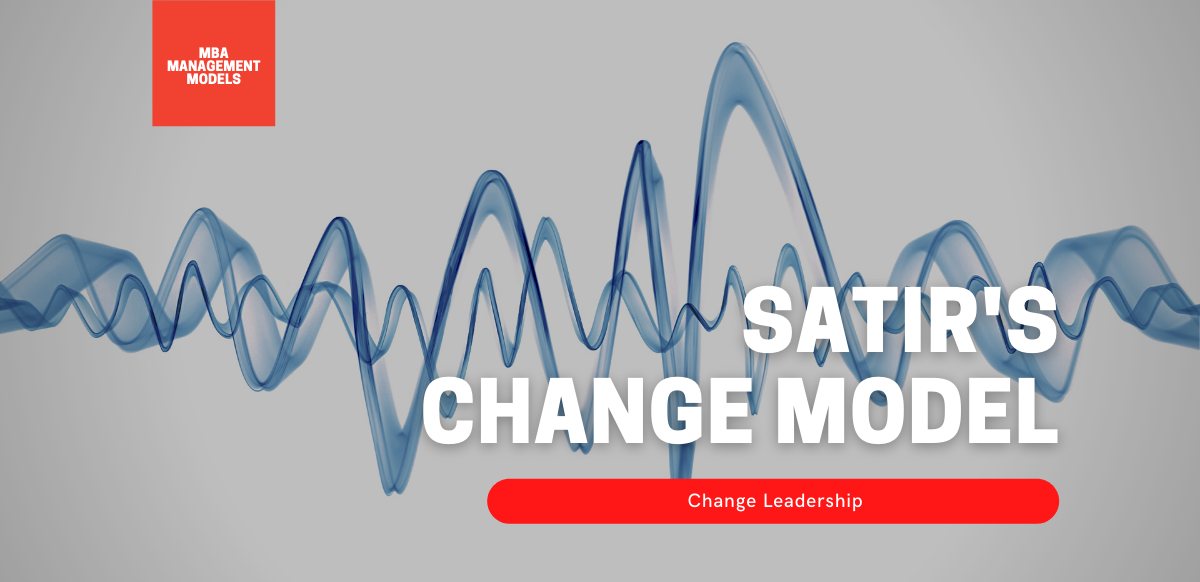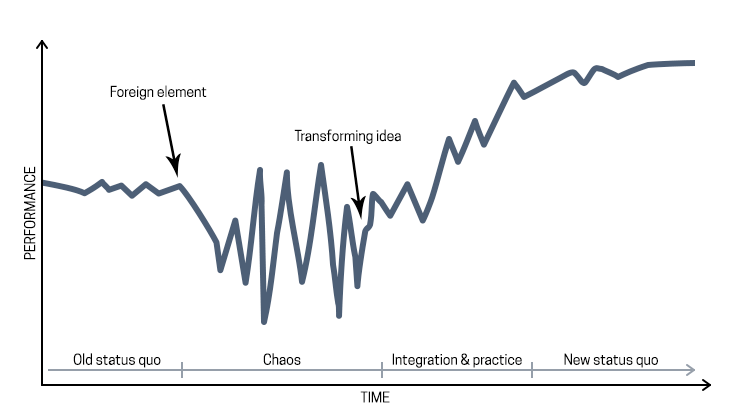Satir's Change Model
Family therapist Virginia Satir developed her model after observing families and individuals experience a wide range of changes. Her model identifies four states of change and two key events that act as catalysts within the process.

What it is
The Satir Change Model describes the series of steps that occur for an individual during any process of change. The model identifies four stages and two key events within the change process:

- Old status quo - This is the current state of familiar equilibrium. Difficulties may be experienced, but no one is affecting any change. In this stage, reliable predictions about the immediate future can be made, and day-to-day events generally remain unchanged from one day to the next. Working practices are well-established and require little or no alteration.
- Introduction of a foreign element - At some point, a new element will enter the system. This may be a change instigated by someone within the company, a change in the market or operating environment, the invalidation of a critical assumption or some other catalyst. Whatever the nature of the foreign element, its introduction into the system will disrupt the status quo and initiate the next stage - chaos.
- Chaos - In the chaos phase, the system is now operating in ways we cannot predict. According to Satir, "The chaos phase is when the healing begins."
The individuals affected by the change may react in different ways during this phase. Some may be in a state of disbelief or denial at first, having lost the sense of security and stability they gained from the old status quo. Some may work to actively resist the change in an attempt to protect the status quo, perhaps even attempting to sabotage any new plans and ideas. Dread, panic, anger and disorganisation are commonly found in varying degrees during this stage, but at some point, the next event, the transforming idea, occurs, signalling the beginning of the end of the chaos. - Transforming idea - At some point, often when the situation has reached its very lowest point, a transforming idea occurs. This happens as the feelings of denial and disbelief subside, and the mood shifts to one of acknowledgement and acceptance. The transforming idea shows a potential way forward and gives a glimmer of hope that the chaos may end and a new, better status quo can be found.
- Integration and practice - In this stage, a plan is generated from the transforming idea, and implementation begins. This will take time and effort, but with sufficient commitment from all involved, the chaos will start to fade, and new working patterns will be found. However, established habits are hard to break, so everyone will need to practice and persevere. Managers will need to lead by example and monitor the implementation to ensure that new approaches are anchored in the culture (see Kotter's Eight Steps).
- New status quo - Once the integration and practice phase is over, the new ways of thinking and working are firmly embedded, and a new status quo is established. This marks the end of the change process, although it will begin again should another sufficiently disruptive foreign element enter the system in the future.

Background
Virginia Satir was a pioneer in the field of family reconstruction therapy. In 1991, three years after her death, her work was published in "The Satir Model: Family Therapy and Beyond" (see Further reading).
Soon after its publication, business management academics began to identify the usefulness of her change model in predicting, understanding and managing employee reactions to change and transformation initiatives.
When to use it
- To understand the emotional state of employees involved in significant change.
- When creating a plan for change within an organisation.
- To counter resistance to change.
- To prevent a change from reverting to its previous state.
How to use it
The model is helpful to managers and leaders in predicting, understanding and managing the emotional health of employees involved in change processes.
It can be helpful to acknowledge the stress and underlying dynamics, such as fear, and explain to struggling team members that their feelings are a normal part of the change process. It is also important to remember that not every team member will move through the process at the same pace and that emotional stages may well overlap for individuals. It is also possible that individuals may revert to previous emotions or even whole stages if an adequate resolution was not found.
The model can help move the change process along by guiding staff towards the next stage. The model is also valuable for managers planning change to remind them of the emotional impact on staff and the performance impact of change processes, at least in the short term, thus allowing them to plan accordingly and provide additional support as necessary.
Related models

Further reading
Satir, V., Banmen, J., Gerber, J. and Gomori, M. (1991) The Satir Model: Family Therapy and Beyond. Palo Alto, CA: Science and Behavior Books.


